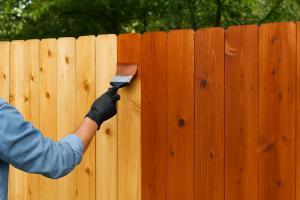How to Choose the Right Stain or Finish for Wood Fences in Southeast Louisiana
Learn how the right stain protects wood fences from Louisiana’s sun and rain while enhancing curb appeal.
COVINGTON, LA, UNITED STATES, September 29, 2025 /EINPresswire.com/ -- In Southeast Louisiana, where heavy rain, blazing sun, and year-round humidity test every outdoor surface, a wood fence needs more than craftsmanship — it needs protection. The right stain or finish can make all the difference, turning a good fence into one that lasts decades. For over 30 years, Tony’s Fencing and Iron Works has helped homeowners choose the ideal finishes that not only preserve natural beauty but also stand up to Louisiana’s unpredictable weather.
The Louisiana Challenge: Sun, Rain, and Humidity
A wooden fence is constantly exposed to the elements. Intense UV rays fade the color, humidity invites mildew, and frequent storms soak the boards, leading to warping, cracking, and rot. Without a proper stain or sealant, even a newly built fence can begin deteriorating within its first year.
“Louisiana’s climate is beautiful, but it’s tough on wood,” says Tony Ostrowski, owner of Tony’s Fencing and Iron Works. “A good stain gives your fence armor — it seals out moisture, blocks sunlight, and helps it stay strong and attractive for years.”
A high-quality finish not only adds color and character but also acts as a protective barrier, locking out moisture and extending the life of your fence.
Choosing the Right Stain or Finish
Homeowners often ask: What’s the best stain for my fence? The answer depends on your fence’s wood type, the look you want, and how much maintenance you’re willing to do.
Transparent Stains let the wood’s natural grain shine through while providing a light tint and basic UV protection — great for fresh cedar fences.
Semi-Transparent Stains add more pigment and deeper color, ideal for homeowners who want both style and strength.
Solid Stains create a rich, consistent color and offer the highest level of sun protection, perfect for older fences or a bolder design.
Clear Sealants protect from water but not sunlight, so they require more frequent reapplication in Louisiana’s climate.
Tony’s team helps homeowners select the right balance of color, protection, and longevity based on each property’s conditions.
When to Apply Stain
New fences need a little time to breathe. After installation, wood should dry out for four to six weeks before staining. Too early, and moisture trapped inside can prevent proper absorption; too late, and the sun can already start fading the surface.
The best time to stain is a mild, dry week — no rain in the forecast, temperatures between 50°F and 80°F, and low humidity.
Why Professional Application Matters
DIY staining might seem simple, but professional application ensures better coverage and longer-lasting results. Tony’s team uses premium stains formulated for Louisiana’s weather, applied evenly with professional-grade sprayers and rollers. They inspect every board, fill gaps, and smooth rough surfaces before applying the first coat — details that make a big difference over time.
Professionally stained fences age more gracefully, resist fading longer, and require less maintenance in the long run.
Maintenance: Keeping Your Fence Beautiful
Even the best stain needs care. Homeowners should wash the fence annually to remove dirt and mildew, and plan to reapply stain every 2–3 years depending on exposure. Watch for signs of fading or water soaking into the wood — those are cues it’s time for a refresh.
To protect the base, keep plants and mulch a few inches away to allow air circulation. Avoid letting vines grow directly on the boards, as they trap moisture and can lead to decay.
With routine care, a stained fence can remain strong and vibrant for 20 years or more — a worthwhile return on investment.
FAQs
Q: What’s better — oil-based or water-based stain?
A: Oil-based stains penetrate deeper and offer longer-lasting protection, while water-based stains dry faster and are more eco-friendly. Tony’s team helps match the best type to each homeowner’s needs.
Q: Can staining change the color of my fence?
A: Absolutely. From warm cedar tones to deep espresso or even modern grays, stains offer a range of design choices.
Q: How can I tell when it’s time to restain?
A: Sprinkle water on the surface. If it soaks in rather than beading up, it’s time to reapply.
A Trusted Local Partner
For Tony Ostrowski, owner of Tony’s Fencing and Iron Works, every fence tells a story. “We’ve seen families invest in beautiful wood fences only to watch them fade too soon. The right stain preserves your investment — it’s like sunscreen and raincoat combined,” he said. “We love helping homeowners protect what they’ve worked so hard to build.”
Tony’s team offers free consultations across Covington and Southeast Louisiana, guiding clients through wood selection, stain color, and long-term maintenance plans.
About Tony’s Fencing and Iron Works
Tony’s Fencing and Iron Works has been a trusted name in Southeast Louisiana for over 30 years, specializing in custom wood, vinyl, and ornamental iron fences, automatic gates, and ADA-compliant handrails. Known for craftsmanship and local expertise, Tony and his crew build fences designed to last through Louisiana’s toughest seasons.
Media Contact:
Tony’s Fencing and Iron Works
Phone: 985-703-0595
Website: www.tonysfencingandiron.com
Location: Covington, Louisiana
Gwen M.
Designs For You
email us here
Visit us on social media:
Facebook
Legal Disclaimer:
EIN Presswire provides this news content "as is" without warranty of any kind. We do not accept any responsibility or liability for the accuracy, content, images, videos, licenses, completeness, legality, or reliability of the information contained in this article. If you have any complaints or copyright issues related to this article, kindly contact the author above.

